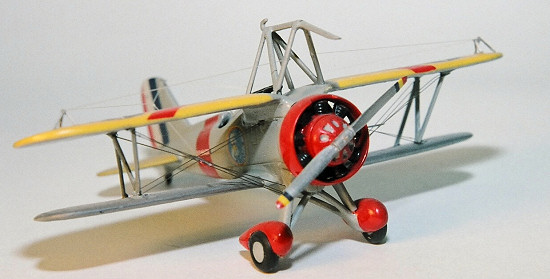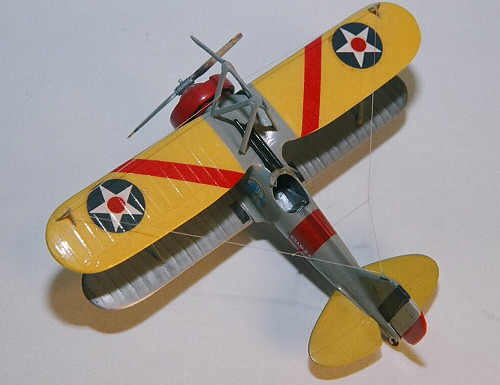
Pegasus 1/72 F9C Sparrowhawk
| KIT #: | ? |
| PRICE: | $ |
| DECALS: | one options |
| REVIEWER: | Joel Hamm |
| NOTES: | Short run, now out of production |

| HISTORY |
Pegasus was one of the first,
possibly the first, “cottage industry” producer of short run injection molded
plastic kits. Based on quality, it was probably the best. It is the only one of
the initial half dozen companies still in existence; though it has retreated to
the WWI aircraft niche. (Editor's note. I'm sure Pegasus wasn't the first as I
c an recall others prior to this time including VeeDay in the late 1970s. Pegasus
is still a going concern so it's demise is a bit premature!)
an recall others prior to this time including VeeDay in the late 1970s. Pegasus
is still a going concern so it's demise is a bit premature!)
The WWW is loaded with detailed histories of every aircraft ever conceived. Browse, read, and believe what you wish. These few notes will serve to satisfy the format requirements of this review site: The Sparrowhawk was designed in the first years of the fourth decade of the twentieth century to fulfill a US Navy specification for a small, shipboard fighter. That concept turned out to be unworkable (the “small, lightweight fighter notion was tried repeatedly up through the jet age, always with the same results), but the design was adopted and adapted to the “parasite fighter” (ditto that idea) role envisioned for the two scout airships – the Akron and Macon. The airplanes were launched and recovered using a hook and trapeze mechanism. The arrangement seemed to work, but when both dirigibles were lost the program was shelved. The lone surviving F9C is on display at the Naval Aviation Museum in Pensacola Florida.
| THE KIT |
This was one of the best
examples of first generation short run kits. For the most part, pieces were
crisply molded and fit together without major surgery. A very minor exception
was excessive dihedral of the one-piece upper wing – cured by razor sawing a
kerf under each gull wing angle, then bending and re-gluing with liquid cement.
“For the most part” didn’t apply to the smaller
 bits’n’pieces. The engine was
sort of fuzzy and got swapped out for a radial with “nose bowl” from a wrecked
Monogram F4B. That same casualty also donated the cowl ring, which looked
better than the white metal one provided. A prop also came from the spares
bin. So did struts, and pieces to scratch build the hook-up rig.
bits’n’pieces. The engine was
sort of fuzzy and got swapped out for a radial with “nose bowl” from a wrecked
Monogram F4B. That same casualty also donated the cowl ring, which looked
better than the white metal one provided. A prop also came from the spares
bin. So did struts, and pieces to scratch build the hook-up rig.
| COLORS & MARKINGS |
Pegasus actually supplied some pretty decent decals. Wing chevron and fuselage band were painted, then masked while the yellow and grey respectively went on. Paints were Model Master enamels. (Still are, I might add. Even with all the fancy acrylics and laquers around, haven’t found anything that goes on easier or sticks better.)
| FINAL CONSTRUCTION |
Windshield is a snippet of clear sheet. Antenna and rigging are “invisible thread” (nylon monofilament). A bit too invisible, actually, but stretched sprue is uneven and hard to fasten; while wire in that diameter doesn’t seem to exist.
| CONCLUSIONS |
Mr. Pegasus: if you read this, quit mucking about with those obscure WWI thingies, and mold us some more stuff like this Sparrowhawk.
May 2006
Copyright ModelingMadness.com. All rights reserved. No reproduction in part or in whole without express permission.
If you would like your product reviewed fairly and fairly quickly, please contact the editor or see other details in the Note to Contributors.